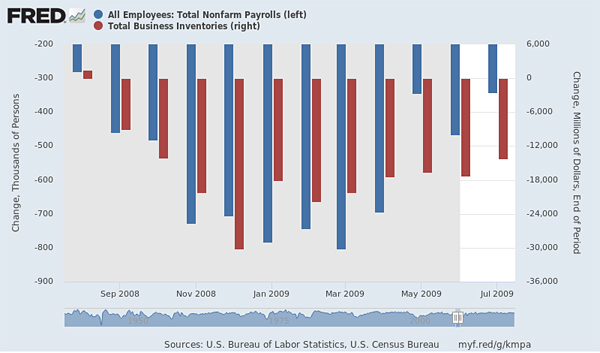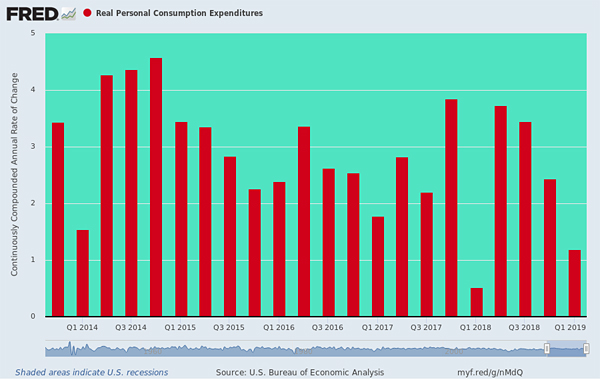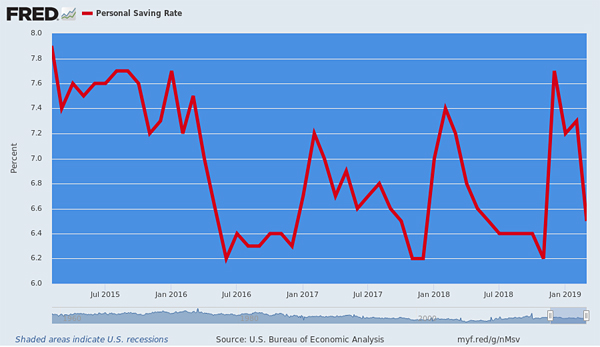The Donald was at it again in Wisconsin this weekend, reiterating his patented boast that the US economy is booming like never before.
We’re now the No. 1 economy anywhere in the world and it’s not even close,” he said on Saturday night at a rally in Green Bay, Wisconsin.
“At the end of six years, you’re going to be left with the strongest country you’ve ever had,” he said.
We beg to differ, profoundly. The debt- and bubble-freighted US economy is actually running out of gas after a long, artificial cycle of tepid expansion; and so far the Donald’s Trade Wars and fiscal borrowing binge have only piled more debilitating baggage on America’s deeply impaired economy.
In fact, the Donald is badly betraying Flyover America because his mindless Fed-bashing virtually guarantees a repeat of the 2008 stock market blow-off and subsequent C-suite fostered recession.
 The Great Deformation:...
Best Price: $2.00
Buy New $9.95
(as of 09:55 UTC - Details)
The Great Deformation:...
Best Price: $2.00
Buy New $9.95
(as of 09:55 UTC - Details)
That is, by essentially shutting down the Fed’s belated normalization campaign, and forcing the Fed head into his humiliating, pusillanimous Powell Pivot, the last feeble barrier against a blow-off top has been removed.
Literally, the robo-machines and feckless buy-the-dips day traders have been unleashed to keep pushing the stock indices higher until the last lemming hits the bid on his way over the cliffs. But once the 2019 version of Wall Street’s post-bubble flameout ignites, there will be no stopping it because there is nothing but bad facts, troubles and headwinds ahead – all of which are being insouciantly ignored in these final moments of Fed-enabled mania.
Indeed, it’s hard to imagine how our clueless central bankers could have done anything more to crush those very ingredients – two-way trade, risk premiums, meaningful carry trade costs and short-seller skepticism – that keep financial markets disciplined, balanced and sustainable.
To be sure, we believe that the Fed was already way, way too late in its belated attempted to get interest rates off the zero bound and shrink its hideously bloated balance sheet toward something that might be vaguely described as normalized. But by capitulating to the Donald’s angry tweets and Wall Street’s juvenile hissy fits at the end of 2018 just when financial discipline became acutely imperative, the Fed catalyzed the worst possible development at month #118 of a business cycle that is literally gasping for air.
To wit, since Christmas Eve the Dow is up 22%, the S&P 500 is higher by 25% and the NASDAQ-100 by a scorching 33%. More importantly, a huge share of those soaring gains in the broad indices are attributable to just six stocks – the so-called FAANGs+M.
That is, Facebook is up 56%, Apple 39%, Amazon 69%, Netflix 59%, Google 25% and Microsoft 38%. In all, these six stocks put on $1.25 trillion of market cap that wasn’t there on Christmas Eve – rising from a combined value of $3.21 trillion to $4.46 trillion in virtually a heartbeat.
So doing, however, the capitulating Fed brought the momo freight train back into the market in the most destructive manner possible. Namely, by igniting one final mindless scramble into the last six momo stocks standing, it caused a sudden (virtually violent) eruption of the overall indices, thereby dragging along the ETFs, indexed funds, benchmark chasing mutual fund managers and the surviving phalanx of Jim Cramer homegamers with them.
That drag-along dynamic is readily apparent in the underlying market cap figures. Thus, the $1.25 trillion rise of the FAANGs+M names since Christmas Eve represented a 39% gain. By contrast, the 494 other stocks in the S&P 500 index were valued at $16.5 trillion at the December 24 interim low and have since risen by about half the FAANGs+M – or by 22.5% to $20.2 trillion.
In turn, of course, this low-volume, momo-driven levitation of the broad market smashed any residual rationality left in the casino. In effect, the FAANGs+M led market cap breakaway after Christmas Eve amounted to a $5 trillion club that pummeled any dissent from the central bank/liquidity driven bubble.
This means that even those one-eye open gamblers who realized by the end of 2018 that it was time to head for the exits or to actually sell short the precarious Peak Trump bubble that had topped out on September 21, have now had their heads handed to them. All semblance of a two-way market has essentially been obliterated – a condition which historically has proceeded the arrival of the proverbial Black Swan (or Red or Orange one as the case may be this time) which finally brings the blow-of mania to an abrupt and violent end.
Indeed, among the myriad follies of central banking during the last several decades virtually nothing compares to the stupidity and cowardice of the Powell Pivot. That’s because the geniuses in the Eccles Building have now seconded the casino to the most reckless speculators and their trend-following robo-machines left in the joint.
There is really no condition more fraught than that. In a $25 trillion stock market, where upwards of 25% of the stock is held by ETFs and explicit and implicit indexers, a Black Swan driven sell-off will rapidly morph into a contagious meltdown because the normal brake – short-sellers buying to cover and take profits – will be entirely AWOL: They are now severely disabled financially or just plain dead.
And that’s where the Donald’s comeuppance comes in. Based on the history of modern Fed-fueled bubble collapses, it can be predicted with high certainty that a market meltdown will trigger a drastic new round of restructurings and layoffs by the corporate C-suites – as they desperately attempt to appease the trading gods of Wall Street and salvage the immolating value of their stock options.
During the 9 months after the Lehman bankruptcy, in fact, 6 million jobs were eliminated and inventories were pared by more than $150 billion or 10%. In all, write-offs of nearly $500 billion were taken in the aftermath – actions which resulted in shuttered stores, closed plants and idle warehouses – as well as canceled orders to suppliers and vendors and a drastic downshift in the pace of over-all business activity owing to these cascading waves of disruption.
Stated differently, what we have today are recessions conceived in the Fed’s swirling pools of liquidity and delivered by the stock-option obsessed C-suites which have metastasized in these toxic environments.
That’s why no one on either end of the Acela Corridor sees it coming.
Your grandfathers’ kind of recession caused by a credit crunch on main street has long ago vanished. It has been superseded by crashing financial bubbles – shocks which cause corporate executives to throw the baby out with the bathwater, as they see themselves becoming impoverished by the minute.
Needless to say, among the Donald’s strong suits, financial numeracy is not one of them. Except we do believe that he understands the precise vote math by which he fluked into the Oval Office – surely even to his own great surprise (and delight).
To wit, he won Pennsylvania by 44,000 votes, Wisconsin by 22,000 votes and Michigan by 10,000. Those three states have 46 electoral votes, which means that without them the Donald would have racked-up only 258 votes in the electoral college; and also a lifetime of vicious persecution by Hillary’s Deep State hit-men for having the audacity to make her sweat out a hairline victory over the weakest, most inept presidential candidate the GOP has ever fielded – including Barry Goldwater and Alf Landon.
Yet, those 76,000 rust-belt votes which actually threw the victory to the Donald represented barely 0.6% of the 13.23 million votes caste in these three crucial swing states.
Needless to say, slather a recessionary economy over those rust belt counties and that 76,000 vote margin of victory would vanish faster than a snowball in the proverbial hot place.
Yet that is exactly why we forecast double trouble in the months ahead. That is to say, the Fed’s giant error in capitulating via the Powell Pivot now guarantees a blow-off crash in the casino and the Donald-killing recession which will inexorably follow.
But it should be more than evident by now that Donald Trump is the most unhinged, brutish, megalomaniacal street-fighter ever to rise to the top of American politics. So when even the first waves of recession begin to lap upon the rust-belt counties on which his political survival – and therefore his personal liberty and financial fortune – depends, he will launch an all-out war of blame on the Fed.
Indeed, to say that the Donald’s virtually assured impending attack on the Fed will make FDR’s 1937 Supreme Court packing gambit look like a Sunday school picnic would be an understatement.
Yet do we think that an already discredited, confused and clueless Fed will be in a position to comfort the casino and bailout the carnage under conditions of all-out political war with the Donald?
We do not. In fact, for the first time in 30 years the boys and girls and robo-machines will be home alone in the casino as the Fed becomes engulfed in a desperate mode of institutional self-preservation.
And we also think the lesson of last Friday’s absurdly misleading GDP report for Q1 indicates that the showdown with the Donald may come a lot sooner than the insouciant gamblers in the casino suspect.
That’s because the US economy is actually quite fragile. Recall that fully 2.1% of the 3.2% headline gain in Q1 real GDP was due to temporary fluctuations in inventory stocking, government spending and the payback for last year’s import surge designed to beat the Donald’s impending 25% tariffs.
Aside from these flaky movements in the GDP accounts, the bread and butter components – household consumption spending, CapEx and housing construction – were quite punk and reflected a slim 1.1% gain for the quarter. As David Rosenburg noted today,
“Drill a little deeper and strip out the things that never go down like food, health care or rent, and the economy actually contracted in Q1.”
In this context, here is the profile of America’s vaunted shop-until-they-drop consumer. The tiny 1.19% annualized rate of gain in Q1 was the second weakest consumer showing since late 2013, and down from 3.8% in Q2 2018, 3.5% in Q3 and 2.5% in Q4.
Moreover, not withstanding the Donald’s fact-free boasting, it is hard to identify any acceleration whatsoever in the trend since January 2017.
To the contrary, the real PCE series shows the same old one-off sugar-high that peaked in Q2 last year, and which has been marching determinedly downhill ever since – the Trumpian/GOP’s credit card-financed tax cut notwithstanding.
We frequently refer to the Donald’s so-called economic advisors as cheerleaders, and this chart underscores exactly why. No competent economist could possibly look at the trend below and claim that the US economy is booming or that the risk of sliding into recession is nonexistent.
Further data released this morning on March income, spending and savings only reinforces the negative implications of the punk fundamentals embodied in the Q1 GDP report.
To wit, ever since recovering to a post-crisis high of about 7.5% in early 2015, the household savings rate has been marching irregularly downhill. That’s because when all else fails, households tap their rainy day funds and retirement accounts (such as they are because roughly 50% of under 60 households have no retirement savings to speak of) in order to pay the bills.
This was evident again in March when the savings rate dropped to a rock bottom 6.5%. What this means, of course, is that even the weak spending trend evident since last year’s Q2 sugar high has been flattered by the drainage of savings accounts.
What comes next is deteriorating performance trends in the consumer credit markets. And that’s exactly what is happening. The Q1 credit card charge-off rate hit 3.82% – the highest level since what was nearly the double-dip recession of Q2 2012.
 Trumped! A Nation on t...
Best Price: $2.05
Buy New $9.50
(as of 06:30 UTC - Details)
Trumped! A Nation on t...
Best Price: $2.05
Buy New $9.50
(as of 06:30 UTC - Details)
Moreover, the loan performance trend has been even more alarming among some of the big credit card issuers. In the case of Capital One, the charge-off rate in Q1 was 5.04%, causing the CEO to warn in his conference call that the company is experiencing notable credit “degradation”.
And that’s with unemployment at 3.9%. No one in the casino even dares to ask, what happens when recession comes?
That’s the true question of the moment. But suffice it here to say that what’s coming after the third central bank-fueled bubble of this century collapses is not Donald Trump on bended knee begging Nancy Pelosi for several trillions of bailout money.
It will be more like the Eccles Building locking itself down on the fear that the National Guard is on its way with instructions from the White House to take no prisoners.
(More amplification here: goo.gl/iGRxVD)
Reprinted with permission from David Stockman’s Contra Corner.







